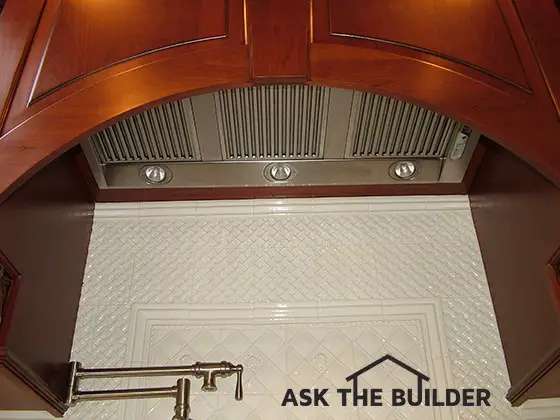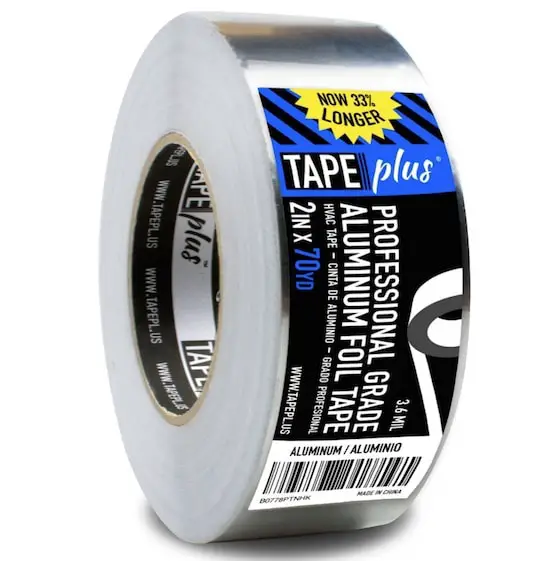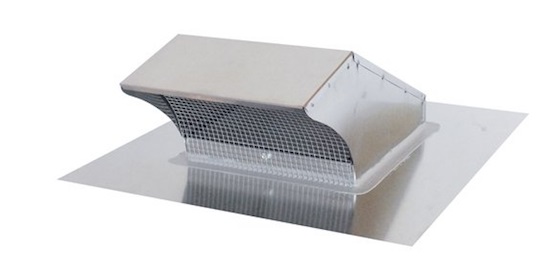Kitchen Exhaust Fan

PHOTO CAPTION: This high-powered kitchen exhaust fan is tucked up under a decorative hood. It is sized properly for the large kitchen. ©2017 Tim Carter
"Generally speaking, I prefer the overhead kitchen exhaust fans rather than the down-draft ones simply because hot air rises."
Kitchen Exhaust Fan TIPS
- Updraft is best
- Replacement air is important
- WATCH roof cap video below
- Use all metal ductwork
- CLICK HERE to Get Tim's FREE & FUNNY Newsletter!
DEAR TIM: My new kitchen plans call for a new kitchen exhaust fan. To be more precise, a kitchen hood exhaust fan has been suggested.
Is one kitchen stove exhaust fan more effective than another? Years ago the down-draft exhaust fans were popular.
What exhaust fan is in your kitchen if you don't mind me asking? How do I make sure the kitchen exhaust fan I select will adequately ventilate my kitchen? Where does the replacement air enter the house? Kathleen K., Exeter, NH
DEAR KATHLEEN: You're asking all of the right questions about your new kitchen exhaust fan.
What Are the Biggest Kitchen Exhaust Fan Mistakes?
The biggest kitchen exhaust fan mistakes are:
- fan not large enough
- vent pipes too small or unsealed
- no makeup air
It's important to realize I see builders and remodelers fall down here. Either the fan installed is not powerful enough for the size of the kitchen, the installer fails to vent it properly, or overlooks the need for makeup air.
CLICK HERE to get FREE & FAST BIDS from local contractors who install fans.
Do the Fans Get Rid of Grease Vapor?
Yes, the exhaust fans do exhaust grease vapor.
It must be remembered you really need a good kitchen exhaust-fan system if you cook greasy foods and boil foods. The cooking process often creates both visible particles as well as an invisible aerosol mist of grease and smoke.
Grease can and does coat the surfaces of your kitchen if they're not vacuumed and exhausted to the exterior of your home. Sooner or later even with a great exhaust fan, you can still develop a fine coating of grease on light fixtures, cabinets, walls, and ceilings. This is the voice of experience talking.
What is the Best Performing Exhaust Fan?
Generally speaking, I prefer the overhead kitchen exhaust fans rather than the down-draft ones simply because hot air rises. Why not use that physical axiom to your advantage and collect the cooking vapors with a hood?
How Do You Size the Fan?
The fan manufacturers have sizing charts that allow you to purchase the correct fan to match the size of your kitchen.
My kitchen exhaust fan is matched to the size of my kitchen. The fan is a powerful three-speed model that has brilliant halogen bulbs that are built-in to the fan.
There are three removable grease-collector screens that we take out regularly and put into our dishwasher. When the fan is on the highest fan speed, it sucks 1,100 cubic feet of air per minute (CFM) from above our cooktop and pushes it outside.
Should I Use Solid Metal Duct to Vent the Fan?
Solid metal duct should be used to vent the fan all the way out and through a roof or a sidewall of your home. Tape all duct seams with aluminum metal duct tape, not plastic tape.

This is metal tape. Yes, it's aluminum that has a high-grade adhesive on the back. This is what pros use to tape ductwork. CLICK THE PHOTO now to have this delivered to your home.
Another key point is the fan is connected to metal ductwork that extends from the fan all the way to the roof of my home.
IMPORTANT TIP: Each joint in the ductwork was carefully taped with special metal-foil duct tape by my ventilation contractor.
It's very important that no air seeps from the duct to other parts of the house. If that were to happen, hidden spaces in your home could become grease-covered posing a significant fire hazard.
How Do You Vent Through the Roof?
The exhaust from my fan exits the roof through a special roof cap that is made to handle that much air flow. It was easy to install so that rain does not enter the house.

>This is a large-capacity roof cap or vent hood. An 8-inch duct connects to it. You need to match the size to your fan. CLICK THIS IMAGE TO BUY THIS ROOF CAP.
Roof Cap Installation Video
Watch the following video to see how to install one of these roof caps.
What is the Formula for Exhaust Fan Sizing?
Many experts simply measure the square footage of the kitchen floor and multiply that by two to arrive at the cubic-feet-per-minute of output for the fan.
For example, since my kitchen is 350 square feet, I would need a fan that must exhaust at least 700 CFM of airflow. My fan can do that on its middle speed, and the highest speed produces the massive 1,100 CFM of air movement.
CLICK HERE to get FREE & FAST BIDS from local contractors who install fans.
How Much Replacement Air is Required?
You need to supply the fan with as much replacement air as it is exhausting out of your home.
You're really observant to recognize that large kitchen exhaust fans like these have a voracious appetite for air. You need to replace every cubic foot of air the fan pushes to the outside.
IMPORTANT TIP: You absolutely must control where the replacement are comes from. You need to put in a special fresh-air intake hood that's large enough to suck in the needed air.
How Do I Avoid Dangerous Backdrafts?
In today's modern homes that are well sealed for energy reasons, sucking that much air out of a house can cause serious backdrafting issues if a makeup air inlet is not installed. Backdrafting can cause deadly carbon monoxide to be drawn back down a chimney or metal vent pipe and/or smoke or smoke odors from fireplaces.
What is the Path of Least Resistance For Replacement Air?
The path of least resistance for replacement air is that path where air enters your home with the least amount of effort.
Newer homes are so airtight that when the air is sucked from a house by a powerful fan, it replaces that air with air from outdoors through the path of least resistance.
That path could be a furnace or water-heater vent, a chimney, or another vent that is open to the atmosphere. Installing a makeup-air vent solves this problem in almost all cases as outside air can easily flow through this device into the home.
Should I Read the Installation Instructions?
Before you buy a kitchen exhaust fan, it's always a good idea to get the written installation instructions from the manufacturer. These documents will often contain sizing guidelines as well as detailed step-by-step methods the manufacturer wants you to follow to keep the warranty in force.
Reading these ensures that the fan you are considering is the right size and that you can satisfy the minimum installation requirements.
What Size Should the Duct Be?
The exhaust duct size should be what's called out in the written installation instructions. Do not go smaller and larger is not a good idea either. Do exactly what the installation instructions say to do.
Resist the temptation to use smaller ducting for the fan. Some people think that the size of the exhaust piping is not that important. Believe me, you must use the exact pipe as called for, and be sure that you do not exceed the maximum length of pipe allowed.
How Many Bends Can I Put in the Ducting?
The written instructions will almost always tell you to avoid 90-degree bends, and how many and what type of bends can be put in the exhaust piping. The instructions will also tell you the maximum length the exhaust duct can be.
These hard bends in the pipe create significant restrictions that make it hard for the fan to exhaust the air from your kitchen.
CLICK HERE to get FREE & FAST BIDS from local contractors who install fans.
Column 725


29 Responses to Kitchen Exhaust Fan